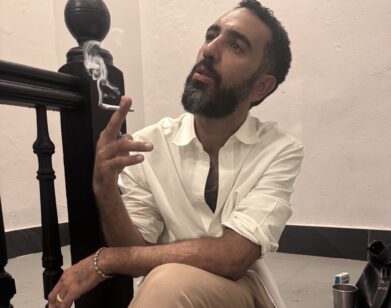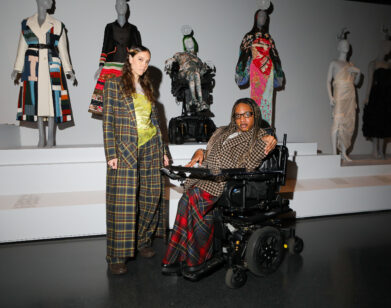ART!
EJ Hill and Jordan Casteel Teach Us How to Paint

EJ Hill “Portrait of the artist,” 2022.
Throughout his career, the Los Angeles-based artist EJ Hill has consistently helped reimagine the limits and demands innate to Blackness, and the tensions between a singular body and the national body politic. Through his performance art and installations, Hill has disrupted and reordered notions of Black embodiment, space, and liminality, earning a residency at The Studio Museum in Harlem in 2016. Hill’s recent installation at Oxy Art, Wherever we will to root, concludes his term as the 2021 Wanlass Artist in Residence, and coincides with his participation in the 2022 Whitney Biennial. Jordan Casteel, herself a painter and a MacArthur Genius fellow, is Hill’s compeer and cohabitant in a cultural milieu newly and feverishly hungry for Black Art (™). Below, the pair riffs on the sustainability and hidden pitfalls of that moment: the unacknowledged labor of Black artistry, the demands placed on the bodies of Black people, flora and fauna, the future of the art world, and the potential for a full and radical liberation of Black creators. Palpable is their fondness and love for each other, how each extends care and curiosity to the other. The following interview was conducted via Zoom.
———
JORDAN CASTEEL: Hi.
EJ HILL: What’s up, boo?
CASTEEL: Not much—seeing you, loving you, all of the things. I feel like every time I hear your voice, my body is overcome with a certain sense of ease.
HILL: Us together—not to sound cheesy—it’s like home. It’s very easy. I’m immediately thinking this whole thing is going to be us just being like, “No you’re great! No, you’re great!”
CASTEEL: We’re not going to do that too much, but I do think you’re great. What comes to your mind knowing that we have this space, this time, this platform, and togetherness on view?
HILL: Meldia [Yesayan] and I, the director of Oxy Arts, were figuring out what to do regarding press around the show—I’ve been resistant to speaking too much about my work. I’m in a sensitive space right now, I feel very raw and exposed. After everything we’ve gone through over the last two years, I want to do things differently. I want to be more in the shadows like, “Alright, I did the work, leave me alone. Don’t email me, don’t call me, I’m napping.”
CASTEEL: What are the challenges in that?
HILL: I’m not sure if shame is the right word, but I do feel some sort of guilt. I recognize that every artist doesn’t have a platform to share work. The irony is that I chased this for so many years, and now that it’s arrived, I find myself wanting to carve out space for myself and not be so preoccupied with another feature or exhibition or art fair. There’s a bit of guilt, because I don’t want to come off like I’m complaining. I want to be able to be grateful for the position I’m in, but also healthy and happy, and those things seem at odds all the time.
CASTEEL: There’s so much duality. You can be hyper-visible and invisible, grateful and uncomfortable at the same time. When you first described this moment, you said that you didn’t want to come off as difficult. As a Black woman I always have this knee-jerk reaction of wanting to make things easy for everyone but myself. How do I make it easy for the curator? How do I make it easy for the person who’s interviewing me? I want everyone to think that I’m accommodating and fun to be around, but by doing that I’m limiting the capacity of my real feelings—that I showed up today and I’m tired and have other things on my mind, I’m actually fraught. I often find myself feeling difficult in the moments where I have to advocate for myself. But really that is me caring for others, too. Maybe I’m saving you today by caring for myself.
HILL: Culturally, there’s a very heightened interest—whether that interest is sincere or not is up for debate—in the cultural production of Black artists and creators. The moment that you and I are navigating currently—professionally, creatively, spiritually—feels really precarious.
CASTEEL: It is precarious, because being in this cultural moment means that people are often engaging with our work in insincere and haphazard ways. People aren’t necessarily engaging with thoughtfulness. There’s that tension between having a moment and being of a moment. I don’t trust that you’re going to take the things that I say and contextualize it in the way that it needs to be contextualized.
HILL: We’ve had to develop mechanisms our entire lives to keep ourselves safe, be it inside or outside the art world. We live in these bodies that are constantly being affronted or under duress, so we have to build up defenses. Asserting our boundaries or saying no to something seems so minor, but that might be the thing that ends up saving our lives.
CASTEEL: I concur, I concur, I concur. This whole interview could end on that and that would be the whole point of everything. It’s literally our lives, and I hope that somebody feels the weight of that. That is the call to action: Look, feel, and listen. That’s what an object that we make, that lives in the world, is asking you to do.

EJ Hill “white rose hymnal,” 2022. Acrylic and graphite on wood panel 61 x 50 3/4 inches. Photographed by Ian Byers-Gamber. Courtesy of Oxy Arts, Los Angeles.
HILL: You put so much into your work, what do you want people to feel and listen to?
CASTEEL: I want people to see me. I’ve done very few self-portraits. In some ways I’m trying to deflect attention from myself, but it’s a really bad deflection, because the work is me. I want people to see that time and labor, and see me. That requires a real deconstruction of the way that you approach a painting, all the constructs and the noise.
HILL: Ever since Made in LA, I’ve been questioning why audiences need to see me suffering and sweating and exorcising demons. If I’m painting flowers, people have a really difficult time with it unless I’m there to explain. Maybe it’s not necessary for me to explain. My job is to be true to the work, make the work, and receive the signals that the universe or god or stardust is dropping into me. As Martha Graham said, “It is your business to keep the channel open, to keep yourself open and aware of the urges that motivate you.” I’m gonna keep painting flowers. What’s going on with your garden?
CASTEEL: The Nasturtium came out of my fraught relationship with paintings—I was putting pressure on myself to paint, and then realizing that I was discontented because I wasn’t allowing myself the creative room to represent what I love. The nourishment that I was getting from the garden felt so much more tangible than the nourishment of other things, like my career. My partner was like, “Well if that’s what’s giving you joy, why don’t you paint it?” I made the painting, and fell in love with it. For my next show, I’m thinking about land and nature and flowers. It’s the perfect metaphor for the way I feel right now. Sometimes the leaves are dying, but at the same time, some are growing—all on the same plant. These paintings feel more vulnerable, like the most honest depiction of myself that I have done. Nasturtium felt like a more honest depiction as a self-portrait than the one I did in 2020.

Jordan Casteel. “Nasturtium,” 2021. Oil on canvas 72 x 56″/182.88 x 142.24cm. © Jordan Casteel. Courtesy of Casey Kaplan, New York
HILL: We were talking about safety, how protected we felt at The Studio Museum. From security to custodial to curatorial to the director—every part of that museum felt like fam. I’m trying to find that in any way that I can—via these floral paintings, via reconnection with you, via chasing my childhood obsession with designing and building my own roller coaster. All of these things are about trying to get back home.
CASTEEL: There are times when I feel like we can find it again, and other times I feel like there’s no place like it. Safety is something that we should constantly be seeking. It’s a gift that [The Studio Museum] gave us. I feel so grateful that we had that experience.
HILL: That space was designed specifically for the safety and protection of Black art and Black artists—and at the time there was no other place like it. Rather than trying to break into places that continue to deny us entry, we can learn from The Studio Museum and The Underground Museum how to fucking build it ourselves. I’ve spent years trying to fit inside these places that were never designed to accommodate me. I just want to be free. Can we be free, as artists? Is that something that we can do within this industry?
CASTEEL: No. I have a hard time imagining it. Not in our lifetime.
HILL: What would it take for us to achieve that level of freedom?
CASTEEL: I think it would require us becoming completely autonomous. I feel responsible to so many people, I owe a lot of people certain things—collectors who have bought my work, curators who gave me shows, galleries that have tried to give me what I wanted. I feel like everybody else has so many needs and wants that it’s hard for me to imagine real freedom.
HILL: Cameron Rowland, who I’m so inspired by and who is making such brilliant work, navigates all of this in a way that is uncompromising: he makes the work and also avoids all the traps. This book by Martin Herbert, Tell Them I Said No, chronicles artists who have refused the art world and its mechanisms. I’m thinking of Cameron and David Hammons and Agnes Martin—people who continue to move quietly or in opposition, but still make important contributions to our culture. I’m learning how to carve out a little space for myself in order to literally survive, just to make it to the end of what I hope to be a long and fruitful life. I just want to be happy.
CASTEEL: And you deserve to be happy. I haven’t figured it out. We’re all figuring it out.
HILL: I get it, this shit is something else. I got you Jordan.
CASTEEL: I know. I got you EJ.
HILL: Teach me how to paint!






